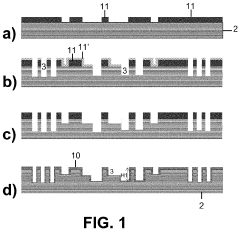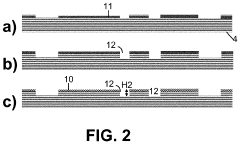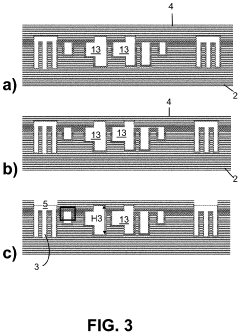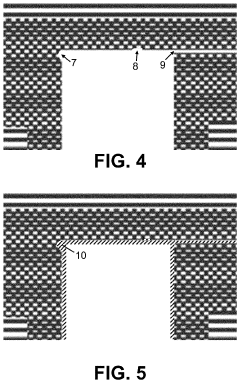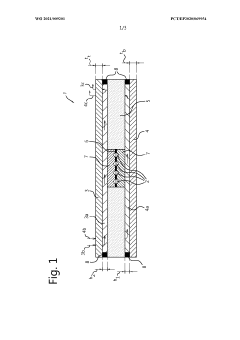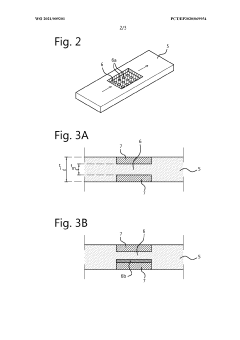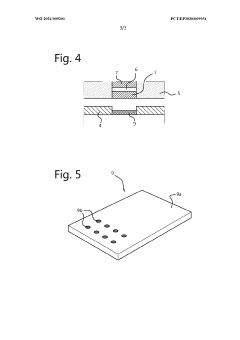Silicon Micropillars for Microfluidic Device Integration
JUL 9, 20259 MIN READ
Generate Your Research Report Instantly with AI Agent
Patsnap Eureka helps you evaluate technical feasibility & market potential.
Silicon Micropillar Background and Objectives
Silicon micropillars have emerged as a promising technology for microfluidic device integration, offering unique advantages in terms of surface area, fluid control, and device miniaturization. The development of silicon micropillars can be traced back to the early 2000s when researchers began exploring their potential in various applications, including microfluidics, biosensors, and lab-on-a-chip devices.
The evolution of silicon micropillar technology has been driven by advancements in microfabrication techniques, particularly in the field of semiconductor processing. Initially, the fabrication of these structures was limited by the available etching and lithography methods. However, as these techniques improved, researchers gained greater control over the size, shape, and distribution of micropillars, leading to more sophisticated and functional designs.
One of the key objectives in silicon micropillar research for microfluidic device integration is to enhance fluid manipulation and control at the microscale. By precisely engineering the geometry and arrangement of micropillars, researchers aim to create highly efficient fluid handling systems that can perform complex operations such as mixing, separation, and filtration within a compact device footprint.
Another important goal is to leverage the high surface area-to-volume ratio of silicon micropillars to improve the sensitivity and efficiency of various analytical and diagnostic processes. This characteristic makes them particularly attractive for applications in biosensing and chemical analysis, where increased surface area can lead to enhanced molecule capture and detection capabilities.
The integration of silicon micropillars into microfluidic devices also aims to address challenges in heat transfer and thermal management. The unique structure of micropillars can facilitate efficient heat dissipation, making them valuable in applications that require precise temperature control or involve exothermic reactions.
Furthermore, researchers are exploring the potential of silicon micropillars to enable novel functionalities in microfluidic devices. This includes the development of smart surfaces with tunable wetting properties, the creation of high-aspect-ratio structures for cell culture and tissue engineering, and the implementation of advanced separation techniques based on size exclusion or affinity interactions.
As the field progresses, there is a growing focus on scalability and manufacturability. Researchers are working towards developing fabrication methods that are compatible with large-scale production, aiming to bridge the gap between laboratory prototypes and commercially viable devices. This involves optimizing processes for uniformity, reproducibility, and cost-effectiveness.
In summary, the background and objectives of silicon micropillar research for microfluidic device integration encompass a wide range of technological and application-driven goals. From improving fundamental fluid handling capabilities to enabling advanced analytical functions, silicon micropillars hold significant promise in revolutionizing the field of microfluidics and lab-on-a-chip technologies.
The evolution of silicon micropillar technology has been driven by advancements in microfabrication techniques, particularly in the field of semiconductor processing. Initially, the fabrication of these structures was limited by the available etching and lithography methods. However, as these techniques improved, researchers gained greater control over the size, shape, and distribution of micropillars, leading to more sophisticated and functional designs.
One of the key objectives in silicon micropillar research for microfluidic device integration is to enhance fluid manipulation and control at the microscale. By precisely engineering the geometry and arrangement of micropillars, researchers aim to create highly efficient fluid handling systems that can perform complex operations such as mixing, separation, and filtration within a compact device footprint.
Another important goal is to leverage the high surface area-to-volume ratio of silicon micropillars to improve the sensitivity and efficiency of various analytical and diagnostic processes. This characteristic makes them particularly attractive for applications in biosensing and chemical analysis, where increased surface area can lead to enhanced molecule capture and detection capabilities.
The integration of silicon micropillars into microfluidic devices also aims to address challenges in heat transfer and thermal management. The unique structure of micropillars can facilitate efficient heat dissipation, making them valuable in applications that require precise temperature control or involve exothermic reactions.
Furthermore, researchers are exploring the potential of silicon micropillars to enable novel functionalities in microfluidic devices. This includes the development of smart surfaces with tunable wetting properties, the creation of high-aspect-ratio structures for cell culture and tissue engineering, and the implementation of advanced separation techniques based on size exclusion or affinity interactions.
As the field progresses, there is a growing focus on scalability and manufacturability. Researchers are working towards developing fabrication methods that are compatible with large-scale production, aiming to bridge the gap between laboratory prototypes and commercially viable devices. This involves optimizing processes for uniformity, reproducibility, and cost-effectiveness.
In summary, the background and objectives of silicon micropillar research for microfluidic device integration encompass a wide range of technological and application-driven goals. From improving fundamental fluid handling capabilities to enabling advanced analytical functions, silicon micropillars hold significant promise in revolutionizing the field of microfluidics and lab-on-a-chip technologies.
Microfluidic Device Market Analysis
The microfluidic device market has been experiencing significant growth in recent years, driven by the increasing demand for point-of-care diagnostics, drug discovery applications, and personalized medicine. The global microfluidic device market was valued at approximately $13.5 billion in 2020 and is projected to reach $27.9 billion by 2026, growing at a CAGR of 12.7% during the forecast period.
The integration of silicon micropillars in microfluidic devices represents a promising technological advancement that addresses several key market needs. These devices offer enhanced performance in terms of fluid control, mixing efficiency, and sample manipulation, which are critical factors in various applications such as biomedical research, pharmaceutical development, and environmental monitoring.
One of the primary drivers for the adoption of silicon micropillar-based microfluidic devices is the growing demand for miniaturized and portable diagnostic tools. The healthcare sector, in particular, has shown a strong interest in these devices for rapid and accurate disease detection, especially in resource-limited settings. This trend has been further accelerated by the recent global health crisis, which has highlighted the need for decentralized testing capabilities.
In the pharmaceutical industry, microfluidic devices with silicon micropillars are gaining traction for drug discovery and development processes. These devices enable high-throughput screening, precise control of reaction conditions, and reduced sample consumption, leading to more efficient and cost-effective drug development pipelines. The market potential in this sector is substantial, with pharmaceutical companies increasingly investing in microfluidic technologies to streamline their R&D processes.
The academic and research sector also represents a significant market segment for microfluidic devices with silicon micropillars. Universities and research institutions are actively exploring the capabilities of these devices for various applications, including single-cell analysis, organ-on-a-chip models, and nanoparticle synthesis. This ongoing research is expected to drive further innovation and expand the potential applications of microfluidic devices in the coming years.
Geographically, North America currently holds the largest market share for microfluidic devices, followed by Europe and Asia-Pacific. However, the Asia-Pacific region is expected to witness the highest growth rate in the forecast period, driven by increasing healthcare expenditure, growing research activities, and rising adoption of point-of-care diagnostics.
Despite the promising market outlook, there are several challenges that need to be addressed to fully realize the potential of silicon micropillar-based microfluidic devices. These include the need for standardization in manufacturing processes, concerns about scalability for mass production, and the relatively high cost of production compared to traditional microfluidic devices. Overcoming these challenges will be crucial for widespread market adoption and commercialization of this technology.
The integration of silicon micropillars in microfluidic devices represents a promising technological advancement that addresses several key market needs. These devices offer enhanced performance in terms of fluid control, mixing efficiency, and sample manipulation, which are critical factors in various applications such as biomedical research, pharmaceutical development, and environmental monitoring.
One of the primary drivers for the adoption of silicon micropillar-based microfluidic devices is the growing demand for miniaturized and portable diagnostic tools. The healthcare sector, in particular, has shown a strong interest in these devices for rapid and accurate disease detection, especially in resource-limited settings. This trend has been further accelerated by the recent global health crisis, which has highlighted the need for decentralized testing capabilities.
In the pharmaceutical industry, microfluidic devices with silicon micropillars are gaining traction for drug discovery and development processes. These devices enable high-throughput screening, precise control of reaction conditions, and reduced sample consumption, leading to more efficient and cost-effective drug development pipelines. The market potential in this sector is substantial, with pharmaceutical companies increasingly investing in microfluidic technologies to streamline their R&D processes.
The academic and research sector also represents a significant market segment for microfluidic devices with silicon micropillars. Universities and research institutions are actively exploring the capabilities of these devices for various applications, including single-cell analysis, organ-on-a-chip models, and nanoparticle synthesis. This ongoing research is expected to drive further innovation and expand the potential applications of microfluidic devices in the coming years.
Geographically, North America currently holds the largest market share for microfluidic devices, followed by Europe and Asia-Pacific. However, the Asia-Pacific region is expected to witness the highest growth rate in the forecast period, driven by increasing healthcare expenditure, growing research activities, and rising adoption of point-of-care diagnostics.
Despite the promising market outlook, there are several challenges that need to be addressed to fully realize the potential of silicon micropillar-based microfluidic devices. These include the need for standardization in manufacturing processes, concerns about scalability for mass production, and the relatively high cost of production compared to traditional microfluidic devices. Overcoming these challenges will be crucial for widespread market adoption and commercialization of this technology.
Current Challenges in Micropillar Fabrication
The fabrication of silicon micropillars for microfluidic device integration faces several significant challenges that hinder widespread adoption and commercialization. One of the primary obstacles is the complexity and cost associated with the manufacturing process. Traditional lithography techniques, while capable of producing high-resolution structures, often require expensive equipment and clean room facilities, making large-scale production economically unfeasible for many applications.
Another major challenge lies in achieving precise control over the dimensions and uniformity of micropillars across large areas. Even minor variations in pillar height, diameter, or spacing can significantly impact the performance of microfluidic devices. This issue is particularly pronounced when scaling up production, as maintaining consistency becomes increasingly difficult over larger substrate areas.
The aspect ratio of micropillars presents another technical hurdle. Creating high aspect ratio structures with sufficient mechanical stability is challenging, especially when considering the need for densely packed arrays. As the height-to-width ratio increases, the risk of pillar collapse or deformation during fabrication or subsequent processing steps also rises, potentially compromising device functionality.
Surface chemistry and wettability control of silicon micropillars pose additional challenges. The hydrophobic nature of silicon can lead to air trapping and bubble formation in microfluidic channels, affecting fluid flow and device performance. Modifying the surface properties of micropillars to achieve desired wetting characteristics without altering their structural integrity remains a complex task.
Integration of micropillars with other microfluidic components and substrates presents further complications. Ensuring proper alignment, bonding, and sealing between the micropillar array and other device layers is crucial for preventing leakage and maintaining overall device functionality. This integration process often requires precise handling and specialized bonding techniques, which can be difficult to implement in high-volume manufacturing settings.
Durability and long-term stability of silicon micropillars in various chemical and biological environments are also concerns. Exposure to certain reagents or prolonged contact with biological samples may lead to degradation or fouling of the micropillar structures, potentially affecting device performance over time. Developing robust surface treatments or protective coatings that do not interfere with the micropillars' intended function remains an active area of research.
Lastly, the challenge of designing micropillar arrays for specific applications while optimizing their fabrication process adds another layer of complexity. Balancing the trade-offs between desired functionality, manufacturability, and cost-effectiveness often requires iterative design processes and extensive experimentation, which can be time-consuming and resource-intensive.
Another major challenge lies in achieving precise control over the dimensions and uniformity of micropillars across large areas. Even minor variations in pillar height, diameter, or spacing can significantly impact the performance of microfluidic devices. This issue is particularly pronounced when scaling up production, as maintaining consistency becomes increasingly difficult over larger substrate areas.
The aspect ratio of micropillars presents another technical hurdle. Creating high aspect ratio structures with sufficient mechanical stability is challenging, especially when considering the need for densely packed arrays. As the height-to-width ratio increases, the risk of pillar collapse or deformation during fabrication or subsequent processing steps also rises, potentially compromising device functionality.
Surface chemistry and wettability control of silicon micropillars pose additional challenges. The hydrophobic nature of silicon can lead to air trapping and bubble formation in microfluidic channels, affecting fluid flow and device performance. Modifying the surface properties of micropillars to achieve desired wetting characteristics without altering their structural integrity remains a complex task.
Integration of micropillars with other microfluidic components and substrates presents further complications. Ensuring proper alignment, bonding, and sealing between the micropillar array and other device layers is crucial for preventing leakage and maintaining overall device functionality. This integration process often requires precise handling and specialized bonding techniques, which can be difficult to implement in high-volume manufacturing settings.
Durability and long-term stability of silicon micropillars in various chemical and biological environments are also concerns. Exposure to certain reagents or prolonged contact with biological samples may lead to degradation or fouling of the micropillar structures, potentially affecting device performance over time. Developing robust surface treatments or protective coatings that do not interfere with the micropillars' intended function remains an active area of research.
Lastly, the challenge of designing micropillar arrays for specific applications while optimizing their fabrication process adds another layer of complexity. Balancing the trade-offs between desired functionality, manufacturability, and cost-effectiveness often requires iterative design processes and extensive experimentation, which can be time-consuming and resource-intensive.
Existing Micropillar Integration Solutions
01 Fabrication methods for silicon micropillars
Various techniques are employed to create silicon micropillars, including etching processes, lithography, and deposition methods. These fabrication methods allow for precise control over the size, shape, and arrangement of the micropillars, which is crucial for their performance in different applications.- Fabrication methods for silicon micropillars: Various techniques are employed to create silicon micropillars, including etching processes, lithography, and deposition methods. These fabrication methods allow for precise control over the size, shape, and arrangement of the micropillars, which is crucial for their performance in different applications.
- Applications in solar cells and photovoltaics: Silicon micropillars are utilized in solar cell and photovoltaic technologies to enhance light absorption and improve overall efficiency. The unique structure of micropillars allows for better light trapping and increased surface area, leading to improved energy conversion rates.
- Use in microfluidic devices and lab-on-a-chip systems: Silicon micropillars play a crucial role in microfluidic devices and lab-on-a-chip systems. They can be used for fluid manipulation, particle separation, and as supports for various chemical and biological reactions, enabling miniaturized and efficient analytical processes.
- Integration with MEMS and sensor technologies: Silicon micropillars are integrated into Micro-Electro-Mechanical Systems (MEMS) and various sensor technologies. Their unique properties allow for enhanced sensitivity and specificity in detecting physical, chemical, and biological parameters, making them valuable in fields such as environmental monitoring and medical diagnostics.
- Surface modification and functionalization of silicon micropillars: Techniques for modifying and functionalizing the surface of silicon micropillars are developed to enhance their properties and expand their applications. These modifications can include chemical treatments, coatings, and the attachment of specific molecules or nanoparticles to tailor the micropillars for specific uses in areas such as catalysis, sensing, and drug delivery.
02 Applications in solar cells and photovoltaics
Silicon micropillars are utilized in solar cell and photovoltaic technologies to enhance light absorption and improve overall efficiency. The unique structure of micropillars allows for better light trapping and increased surface area, leading to improved energy conversion in solar devices.Expand Specific Solutions03 Use in microfluidic and lab-on-a-chip devices
Silicon micropillars play a significant role in microfluidic systems and lab-on-a-chip devices. They can be used for fluid manipulation, particle separation, and as structural elements in miniaturized analytical systems, enabling more efficient and precise control of small-scale fluid dynamics.Expand Specific Solutions04 Integration with MEMS and sensor technologies
Silicon micropillars are integrated into Micro-Electro-Mechanical Systems (MEMS) and various sensor technologies. Their unique properties allow for enhanced sensitivity and functionality in applications such as pressure sensors, accelerometers, and chemical detection systems.Expand Specific Solutions05 Surface modification and functionalization
The surface of silicon micropillars can be modified and functionalized to tailor their properties for specific applications. This includes coating with various materials, chemical treatments, and the addition of functional groups to enhance their performance in areas such as biosensing, catalysis, and energy storage.Expand Specific Solutions
Key Players in Microfluidic Integration
The research on Silicon Micropillars for Microfluidic Device Integration is in a growth phase, with increasing market potential and technological advancements. The global microfluidics market is expanding rapidly, driven by applications in healthcare, pharmaceuticals, and life sciences. Key players like HP Development Co., Koninklijke Philips, and Corning are investing in this technology, leveraging their expertise in materials and manufacturing. Research institutions such as Caltech and IMEC are contributing to technological innovations, while companies like Bio-Rad Laboratories and Agilent Technologies are focusing on practical applications. The technology is maturing, with improvements in fabrication techniques and integration capabilities, but there is still room for significant advancements in scalability and cost-effectiveness.
Corning, Inc.
Technical Solution: Corning has developed advanced silicon micropillar technology for microfluidic device integration. Their approach involves creating high-aspect-ratio silicon micropillars using deep reactive ion etching (DRIE) techniques. These micropillars are precisely engineered with diameters ranging from 1-10 μm and heights up to 100 μm, allowing for efficient fluid handling and precise control of flow dynamics[1]. Corning's silicon micropillars are functionalized with various surface chemistries to enhance their performance in applications such as biomolecule separation, cell capture, and chemical sensing. The company has also integrated these micropillars into lab-on-a-chip devices, enabling miniaturized and highly efficient analytical platforms[2].
Strengths: Expertise in materials science, established manufacturing capabilities, and a strong patent portfolio. Weaknesses: Potential high production costs and complexity in scaling up for mass production.
Interuniversitair Micro-Electronica Centrum VZW
Technical Solution: IMEC has pioneered the development of silicon micropillar arrays for microfluidic applications. Their approach focuses on creating highly ordered, densely packed micropillar structures using advanced lithography and etching techniques. IMEC's silicon micropillars feature diameters as small as 500 nm and aspect ratios exceeding 20:1, enabling exceptional fluid handling capabilities[3]. The center has developed innovative methods for integrating these micropillars into microfluidic channels, including techniques for creating gradient structures and multi-level pillar arrays. IMEC's research has demonstrated the use of these micropillar arrays in applications such as DNA separation, protein analysis, and cell sorting, achieving high-throughput and high-resolution performance[4].
Strengths: Cutting-edge research facilities, collaborations with industry partners, and expertise in nanofabrication. Weaknesses: Potential challenges in translating research into commercial products and limited manufacturing experience.
Core Innovations in Silicon Micropillars
Method for Fabricating a Microfluidic Device
PatentPendingUS20210300752A1
Innovation
- A method involving direct bonding of silicon substrates with hydrophilic silicon oxide surfaces, followed by exposure to oxidative species and heat to form silicon oxide, which fills gaps and defects, enhancing fluid transport and channel sharpness.
Microfluidic device
PatentWO2021009201A1
Innovation
- A microfluidic device with a specially designed insert featuring a membrane with larger pores and a hydrogel system that accommodates three-dimensional cell structures, allowing for extended culture periods and real-time imaging, along with a method for using the device to culture tumor slices and integrate immune cells for immunotherapy modeling.
Materials Science Advancements
Recent advancements in materials science have significantly contributed to the development of silicon micropillars for microfluidic device integration. The evolution of silicon-based materials and fabrication techniques has enabled the creation of highly precise and functional micropillar structures. These structures play a crucial role in enhancing the performance and capabilities of microfluidic devices.
One of the key advancements in this field is the improvement of silicon etching techniques. Deep reactive ion etching (DRIE) has emerged as a powerful method for creating high-aspect-ratio micropillars with exceptional precision and uniformity. This technique allows for the fabrication of pillars with diameters ranging from a few micrometers to tens of micrometers, and heights up to several hundred micrometers.
Surface modification of silicon micropillars has also seen significant progress. Researchers have developed various methods to functionalize the pillar surfaces, enhancing their interaction with fluids and biomolecules. These modifications include the application of self-assembled monolayers, plasma treatments, and chemical vapor deposition of thin films. Such surface treatments enable the tailoring of surface properties like hydrophobicity, hydrophilicity, and chemical reactivity.
The integration of novel materials with silicon micropillars has opened up new possibilities for microfluidic device functionality. For instance, the incorporation of stimuli-responsive polymers onto silicon micropillars has led to the development of smart microfluidic systems capable of controlled fluid manipulation. Additionally, the use of nanoparticle-coated micropillars has shown promise in enhancing sensing capabilities and catalytic activities within microfluidic devices.
Advancements in nanofabrication techniques have also contributed to the field. Electron beam lithography and nanoimprint lithography have enabled the creation of nanoscale features on silicon micropillars, further expanding their potential applications. These nanoscale modifications can significantly increase the surface area and introduce unique properties at the nanoscale level.
The development of hybrid materials combining silicon with other materials like glass, polymers, or metals has led to innovative microfluidic device designs. These hybrid structures leverage the strengths of different materials to create devices with enhanced functionality, durability, and biocompatibility. For example, the integration of transparent materials with silicon micropillars has facilitated improved optical detection capabilities in microfluidic devices.
One of the key advancements in this field is the improvement of silicon etching techniques. Deep reactive ion etching (DRIE) has emerged as a powerful method for creating high-aspect-ratio micropillars with exceptional precision and uniformity. This technique allows for the fabrication of pillars with diameters ranging from a few micrometers to tens of micrometers, and heights up to several hundred micrometers.
Surface modification of silicon micropillars has also seen significant progress. Researchers have developed various methods to functionalize the pillar surfaces, enhancing their interaction with fluids and biomolecules. These modifications include the application of self-assembled monolayers, plasma treatments, and chemical vapor deposition of thin films. Such surface treatments enable the tailoring of surface properties like hydrophobicity, hydrophilicity, and chemical reactivity.
The integration of novel materials with silicon micropillars has opened up new possibilities for microfluidic device functionality. For instance, the incorporation of stimuli-responsive polymers onto silicon micropillars has led to the development of smart microfluidic systems capable of controlled fluid manipulation. Additionally, the use of nanoparticle-coated micropillars has shown promise in enhancing sensing capabilities and catalytic activities within microfluidic devices.
Advancements in nanofabrication techniques have also contributed to the field. Electron beam lithography and nanoimprint lithography have enabled the creation of nanoscale features on silicon micropillars, further expanding their potential applications. These nanoscale modifications can significantly increase the surface area and introduce unique properties at the nanoscale level.
The development of hybrid materials combining silicon with other materials like glass, polymers, or metals has led to innovative microfluidic device designs. These hybrid structures leverage the strengths of different materials to create devices with enhanced functionality, durability, and biocompatibility. For example, the integration of transparent materials with silicon micropillars has facilitated improved optical detection capabilities in microfluidic devices.
Scalability and Mass Production Considerations
The scalability and mass production of silicon micropillars for microfluidic device integration present both challenges and opportunities. As the demand for microfluidic devices continues to grow across various industries, including healthcare, environmental monitoring, and chemical analysis, the need for efficient and cost-effective production methods becomes increasingly critical.
One of the primary considerations for scaling up production is the optimization of fabrication processes. Traditional methods such as photolithography and etching can be time-consuming and expensive when applied to large-scale manufacturing. To address this, researchers are exploring alternative techniques like nanoimprint lithography and roll-to-roll processing, which offer the potential for higher throughput and reduced costs.
Material selection also plays a crucial role in scalability. While silicon remains a popular choice due to its well-established fabrication techniques and compatibility with existing semiconductor processes, alternative materials such as polymers are gaining attention for their lower cost and easier processing. However, the challenge lies in maintaining the precision and uniformity of micropillar structures across different materials and production scales.
Automation and quality control are essential aspects of mass production. Implementing advanced robotics and machine vision systems can significantly enhance the consistency and speed of micropillar fabrication. Additionally, developing robust in-line inspection methods is crucial to ensure the uniformity and functionality of the produced microfluidic devices.
The integration of micropillars into complete microfluidic systems presents another scalability challenge. Developing standardized interfaces and assembly processes that can be easily automated is vital for efficient mass production. This may involve the creation of modular designs that allow for flexible integration of micropillar components into various device configurations.
Environmental considerations and sustainability are becoming increasingly important in manufacturing processes. As production scales up, it is essential to optimize resource utilization, minimize waste generation, and explore recycling options for materials used in micropillar fabrication. This not only reduces the environmental impact but also contributes to long-term cost-effectiveness.
Lastly, the economic viability of mass production depends on market demand and potential applications. As research continues to uncover new uses for micropillar-based microfluidic devices, the economies of scale are likely to improve, driving down production costs and making these devices more accessible to a broader range of industries and applications.
One of the primary considerations for scaling up production is the optimization of fabrication processes. Traditional methods such as photolithography and etching can be time-consuming and expensive when applied to large-scale manufacturing. To address this, researchers are exploring alternative techniques like nanoimprint lithography and roll-to-roll processing, which offer the potential for higher throughput and reduced costs.
Material selection also plays a crucial role in scalability. While silicon remains a popular choice due to its well-established fabrication techniques and compatibility with existing semiconductor processes, alternative materials such as polymers are gaining attention for their lower cost and easier processing. However, the challenge lies in maintaining the precision and uniformity of micropillar structures across different materials and production scales.
Automation and quality control are essential aspects of mass production. Implementing advanced robotics and machine vision systems can significantly enhance the consistency and speed of micropillar fabrication. Additionally, developing robust in-line inspection methods is crucial to ensure the uniformity and functionality of the produced microfluidic devices.
The integration of micropillars into complete microfluidic systems presents another scalability challenge. Developing standardized interfaces and assembly processes that can be easily automated is vital for efficient mass production. This may involve the creation of modular designs that allow for flexible integration of micropillar components into various device configurations.
Environmental considerations and sustainability are becoming increasingly important in manufacturing processes. As production scales up, it is essential to optimize resource utilization, minimize waste generation, and explore recycling options for materials used in micropillar fabrication. This not only reduces the environmental impact but also contributes to long-term cost-effectiveness.
Lastly, the economic viability of mass production depends on market demand and potential applications. As research continues to uncover new uses for micropillar-based microfluidic devices, the economies of scale are likely to improve, driving down production costs and making these devices more accessible to a broader range of industries and applications.
Unlock deeper insights with Patsnap Eureka Quick Research — get a full tech report to explore trends and direct your research. Try now!
Generate Your Research Report Instantly with AI Agent
Supercharge your innovation with Patsnap Eureka AI Agent Platform!
